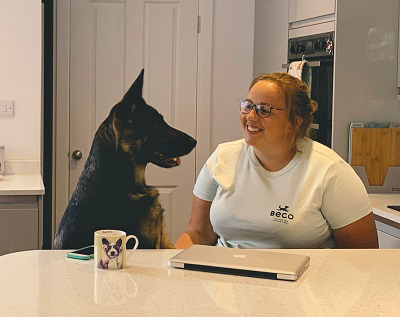
As the Government encourages employees back to the workplace, a leading dog trainer and brand ambassador for Beco has issued a warning to the UK’s 10 million dog owners.
Changes in work routine are proving stressful for many people, especially pet owners who won’t be able to take their dogs into work. And their dogs, who have become accustomed to close and constant companionship for months, are now at risk of developing separation anxiety as lockdown eases.
Around one third of the UK’s canine population, up to three million dogs, are at risk, says Bryony Cole, one of Britain’s top dog trainers and a brand ambassador for Beco.
Bryony, founder and head trainer at her Somerset dog training company Eye2EyeDogs, owns three dogs herself and has trained thousands of others, often helping dogs to cope with anxiety and stress. She has also trained many dogs for roles in UK films and TV programmes.
Bryony said: “As many people return to their normal place of work, their dogs will undoubtedly be feeling stressed. Most puppies, for example, may have known no other life other than having their owner at home with them full-time.
“There are 10 million dogs in Britain and about a third of them are now at risk of developing separation anxiety. Not every dog owner has a job that will take them away from the home, say to an office, but up to 3 million dogs will now be at risk.
“Therefore, it’s very important that we keep a close look-out for any early signs that a dog is feeling distress and take appropriate action to help them without delay.”
Drawing on her huge experience Bryony has come up with a list of lockdown dos and don’t to help dogs and their owners transition to new ways of working:
Lockdown exit dos
Tip 1 – Start preparing now for leaving your dog. If you ease in your new protocol gradually, you shouldn’t have any issues leaving your dog when everything finally returns to normal. Aim for 5-15 minutes’ training with your dog each day. Teach them some fun tricks. There are many tutorials on YouTube.
Tip 2 – Prepare some enrichment toys by stuffing them with healthy, high-value foods, then freeze them so they’ll last a bit longer for your dog. Special treats can be pre-made and ready to use just as you leave for work.
Tip 3 – Give them some home alone time. If you can, erect stair gates or room partitions so you can start having brief moments of ‘alone time’ to yourself, apart from your dog. Pop out for some gardening while your dog enjoys a treat or enrichment toy inside.
Tip 4 – Plan exciting walks: don’t put your dog’s day-to-day adventures on the back burner. Physical exercise is crucial to having a happy dog. Explore some new places. Woodlands are great fun as there is lots to sniff and discover.
Tip 5 – Create fun, new activities. Think up some activities for your dog during the day. Recycle an old shoe box to use in a search game or hide treats in a rolled-up towel. Find fun things to stimulate your dog’s brain, satisfy their need to sniff and search – this will tire them out in preparation for being left alone.
Lockdown exit don’ts
Tip 6 – Don’t leave your preparations too late. Post-lockdown, even dogs that were previously happy to be left alone may feel a little anxiety. Start implementing some ‘alone time’ for your dog now, so it doesn’t come as a shock when you leave them and return to work.
Tip 7 – Slowly build up the length of time your dog is left alone. Don’t leave them for hours straight away. Start with a couple of minutes, see how they fare, then slowly build on the time apart.
Tip 8 – Your dog needs physical exercise to be happy and content. Try to take them on some new walks. Don’t forget that daily walk. Dogs denied exercise are more likely to be unable to settle without you.
Tip 9 – If you see a problem arising don’t ignore it. Seek help from a qualified professional immediately if you think your dog may be developing separation anxiety.
Tip 10 – Don’t rush: helping a dog out of separation anxiety is a steady journey. No matter how badly affected they are, taking time is important. Set your dog up for success: stay calm, be patient, include fun in training.
Beco Founder George Bramble, who owns a five-year-old black Labrador named Tarka, said he was very grateful to Beco ambassador Bryony for sharing her wisdom about the risks of separation anxiety in dogs.
“Quite understandably, owners will be concerned for the welfare of their pets at this time when many of us are going back to work and may be having to leave dogs at home.
“As a highly experienced trainer, Bryony is clearly very knowledgeable about dogs’ mental health and behaviour and we are pleased to be able to share her wisdom, experience and advice with the wider public.”


